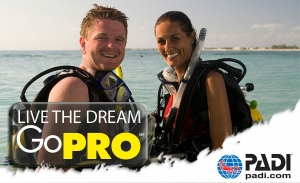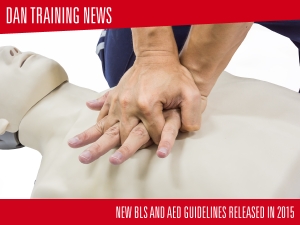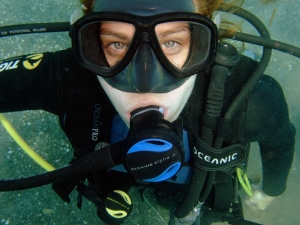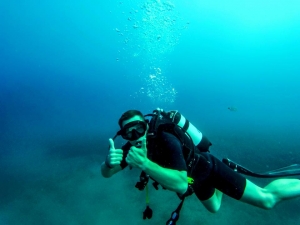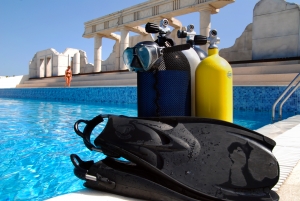Kostas Marmarinos
Padi Divemaster internship 2016
FREE Scuba diving internship 2016 with Kos Divers.
Apply now, only two places available for our free PADI Divemaster Internship for the summer 2016 season.
If you would like to become a professional diver take advantage of a unique opportunity and a lifetime experience.
We offer full training up to PADI Dive Master level, all course materials included plus free accommodation. The Divemaster course will improve your general diving skills and knowledge, teach you how to assist with student divers, lead dive trips, improve your rescue skills and much more.
On completion you will be a true dive professional and ready to work within the Dive Industry. In return we require your hard work and commitment to help maintain our dive centre’s excellent reputation for supreme safety and customer service.
Minimum Requirements:
- EU passport
- 18 years old
- Must own part of scuba equipment (if not, must be willing to buy full/part of equipment in wholesale price from our dive shop)
- Health medical statement (not exceeding 6 months)
- Medical insurance
- Must be able to commit for a 4-5 months period.
- Candidate must send full body photo
Please send your CV and a current photograph to: [email protected]
We are a small Greek/British family run successful business, we have genuine ethics and we want you to become a valued and respected member of our team. If you wish to continue to PADI Open Water Instructor level, we can help you arrange your IDC, we have so far a 100% pass rate!!
Please get in touch with us as we’re sure you have many questions, we are happy to help in every way we can. Don’t just take our word for it……check out our reviews on Trip Advisor!
For more information's please visit our web site: wwww.kosdivers.com, our facebook page https://www.facebook.com/kosdivers/ or our facebook group https://www.facebook.com/groups/26524953
A Healthy Heart Workout for Divers
A Healthy Heart Workout for Divers
The stresses of the underwater environment and use of scuba equipment can reduce a diver’s breathing capacity by as much as 40 percent of that on the surface. What’s the best way for divers to stay heart healthy and maintain even breath?
Research demonstrates that breathing through the mouth rather than the nose adds to the stresses placed upon a diver, because the diver already has to work harder at simply breathing through a regulator. This is called the “work of breathing.” When we add the additional physical stress of breathing gases, psychological stresses, i.e., feeling of shortness of breath or breathlessness, appear as well. Cold temperatures also increase the energy costs associated with oxygen utilization throughout the body. Respiratory limitations of divers at depth may require increased respiratory rates. Finding a healthy heart workout for divers is key to alleviating these stressors.
On land, the limiting factor to the amount of work that a body can do is usually the cardiovascular system or the heart. Underwater, the limiting factor is probably the respiratory system, so divers who maintain a good level of cardiorespiratory fitness reduce the risks associated with scuba diving and improve overall diving performance. The purpose of cardiorespiratory fitness is to maintain and improve the efficiency of the heart, lungs and vascular system. Cardiorespiratory fitness is achieved through aerobic exercise.
Based on a review of reported medical conditions by scuba divers, heart disease, cardiovascular illness and high blood pressure are the most prevalent health concerns. The good news is that aerobic exercise helps to prevent heart disease, high blood pressure and high cholesterol, and may help repair the damage from smoking.
It’s easy to understand why aerobic exercise is a necessary fitness component for scuba divers. Positive results of an aerobic program, such as easier execution of daily activities, are apparent within weeks. However, the benefits of aerobic exercise diminish dramatically in as little as two weeks of inactivity. The best results are achieved when aerobic exercise is performed consistently as part of a healthy lifestyle.
Aerobic exercise is any activity that creates and utilizes greater oxygen demand by moving primarily the large muscles of the body, repeatedly and rhythmically, at a particular intensity beyond the usual activity of rest or relaxation. Examples of aerobic exercise are walking, jogging, running, swimming, rowing, cycling, jumping rope, aerobics classes and dancing. Aerobic exercise may be performed outdoors almost anywhere; fitness centers and gyms provide plenty of equipment such as treadmills, stair climbers, ellipticals and exercise bikes as well.
The American Heart Association (AHA) recommends moderate-intensity aerobic activity at least five days per week for at least 30 minutes for a total of 150 minutes; or at least 25 minutes of vigorous aerobic activity at least three days per week for a total of 75 minutes; or a combination of moderate- and vigorous-intensity aerobic activity and moderate- to high-intensity muscle-strengthening activity at least two days per week for additional health benefits. For lowering blood pressure and cholesterol, the AHA recommends an average of 40 minutes of moderate- to vigorous-intensity aerobic activity three or four times per week. As divers, our sport may not be aerobic, but participating in a healthy heart workout will help keep us fit both on land and underwater.
Safe descent techniques
By guest blogger Beth Alexander
It’s important to learn proper descent techniques and to descend in a controlled manner in order to avoid any complications. Here are a few tips to make your first (or next) descent a breeze.
Descending too fast can lead to an increased risk of equalization problems, so don’t rush it. Control your descent to allow air spaces, such as ears, sinuses and mask, to equalize as the pressure changes during your descent. After you and your buddy have made your entries, relax, regroup and recheck. If you’ve got time before the group descends, float comfortably buoyant on the surface with your snorkel or regulator in your mouth. Then, simply place your face in the water and take a moment to establish a comfortable breathing pattern. It’s this breathing pattern that will help you relax and make your descent a lot easier and your dive more enjoyable. You can then begin to recheck your equipment to make sure that nothing has come lose on your entry, or that any hoses are leaking or free flowing.
A diver must be able to control their descent to make sure that they do not harm or damage the environment below them — a simple errant fin kick could kill the coral or injure aquatic life. Even if descending onto a sandy bottom, you could stir up the sediment, resulting in decreased visibility, so watch where you’re going.
When descending it is important to stay close to your buddy, so that he or she can help with any potential problems and so that you can avoid buddy separation.
Equalize your ears on the surface before trying to descend. By doing so you are preparing them for subsequent equalizations and helping to compensate for the initial and more-extreme pressure changes near the surface. This should help reduce any equalization problems that may occur during your descent. Equalize with every breath during your first 30 feet, even if you feel you don’t need to, and be sure to equalize before you start feeling pain in your ears.
Perform a weight check. Being weighted correctly will help you descend in a more controlled manner. Never try to force a descent, i.e. by duck-diving down, as this can lead to further complications on your dive. Take your time to get your weighting right.
Once the signal has been given to descend, only proceed when you’re comfortable and ready to do so with your buddy. Hold up your low-pressure inflator and release all the air from your BCD, but also remember to breathe out. Your lungs also act as BCD, so controlled outward breaths will help you descend in a controlled manner.
Another simple way to make your descent easier, and one that many new divers forget, is to simply stop finning. Stop all kicking and other body motions and simply relax in the water, allowing your BCD to control your buoyancy.
When you’re new to diving, using a reference line can also help you control your depth and speed of descent. If you ever feel more comfortable using a line to descend, never feel shy to ask for one.
We hope these simple tips make your next descent easier, but the most important one we’ve shared is to remain calm and comfortable. The more comfortable and in- control you feel, the easier the descent and, therefore, the more enjoyable the dive.
Gastrointestinal Issues
Gastrointestinal Issues
Consider them Before Returning to Diving
By David Vote, M.D.
Introduction
Specific medical problems with the gastrointestinal tract (GI system) do not generate many calls on the DAN Medical Information Line. But each year, however, callers ask DAN about fitness-to-dive questions involving the GI system.
Since the GI system contains air spaces, we should view them in relation to scuba diving, along with diseases of the esophagus, stomach, small and large intestines. Like diseases of other body systems, GI problems can weaken individuals and restrict them from certain types of physical activity.
In this series of frequently asked questions*, physicians have determined which disease conditions might not be compatible with the physiology of scuba diving. Many individuals with chronic, long-term disease stop diving altogether, while others experiencing more acute disease may only have to wait out their current illness to resume diving. Physicians use their experience and theory to make the most prudent decision when or if one should return to diving. That is what DAN tries to provide with this article and others like it.
More and more individuals with special health concerns are considering scuba for their recreational activity; others may wish to remain in scuba after they develop a medical condition. These articles help address this need for new divers and aid the instructors and stores that are responsible for providing training. Although study data linking medical illnesses to diving is limited, we will continue to do our best to find answers for some of these difficult questions.
— Joel Dovenbarger, R.N., Vice President, DAN Medical Services
Don’t Overlook It
Fitness to dive with gastrointestinal conditions doesn’t have as high a profile as other conditions, but divers should not be complacent about obtaining such a medical evaluation. Several GI conditions can significantly affect dive safety.
The No-Nos
Two classes of conditions can contain absolute contraindications:
- those that can cause gastric and intestinal gas-trapping at depth; this can lead to subsequent expansion — and possible rupture — on ascent; and
- conditions that increase the risk of vomiting underwater, which can lead to panic, rapid ascent, aspiration or drowning.
Relative contraindications involve conditions that can be surgically repaired or have a pattern of acute episodes followed by long symptom-free periods. Many factors prevent patients with such gastrointestinal conditions from diving:
- Scuba diving in remote locations or from a boat with minimal or no definitive medical care for emergencies;
- Fluid and electrolyte losses that can occur with acute conditions and rendering the individual more susceptible to DCI and heat stroke;
- Head-down positions, common in diving, which increase tendency to regurgitate; and
- Chronic bowel inflammation, which can cause poor nutrition and hence a general lack of cardiovascular fitness.
Those with either condition should recover general strength and fitness and then resume diving.
COMMON ACUTE CONDITIONS
Gastroenteritis — with Vomiting / Diarrhea
Condition: This irritation of the large and small bowel can lead to diarrhea, vomiting, fever, abdominal pain and cramping, loss of appetite and general weakness. Caused by various bacteria or viruses, it may also indicate other gastrointestinal disease. Often mild and lasting only a day or two, it can be severe and cause life-threatening dehydration.
Fitness and Diving: Malaise and dehydration can both adversely affect divers; one should postpone diving until symptoms have subsided and hydration is normal. To maintain or regain hydration, take extra fluid as tolerated. Divers should remember that medications used to control nausea, vomiting and diarrhea may have some adverse side effects, such as sedation.
Small Bowel Obstruction
Condition: Obstruction of the small bowel refers to the intestinal blockage due to adhesions (external bands), scarring, external compression, twisting or entrapment of the bowel within a hernia (see Hernias). Vomiting and abdominal pain are symptoms.
Fitness and Diving: Almost all individuals with bowel obstruction will be hospitalized. Because of possible over-distension and rupture, those with such an obstruction should avoid diving until the underlying problem has been corrected.
CHRONIC CONDITIONS
These conditions are lifelong or of long duration.
Gastroesophageal Reflux (“Heartburn” or “Waterbrash”)
Condition: “Reflux” is a backward flow of acid or food from the stomach into the esophagus. Symptoms include burning upper abdominal or chest pain, sour taste or food regurgitation, which can happen when divers are in the head-down position. Symptoms can be exacerbated by:
- drinking alcohol;
- smoking;
- an ulcer or hiatal hernia;
- certain medications such as aspirin or non-steroidal anti-inflammatory drugs (NSAIDs); or
- a tight-fitting belt or wetsuit.
Physicians treat reflux with medications or through surgery.
Fitness and Diving: While most people may experience occasional mild heartburn, if reflux of gastric contents occurs while one is diving, a diver could be at significant risk. Aspirating food or acid into the lungs or into the regulator could be fatal. Individuals with significant reflux should not dive.
Achalasia
Condition: A disorder of the esophageal smooth muscle, achalasia has two components: the lower esophageal sphincter that does not relax with swallowing and abnormal contractions that replace the normal movement of the esophagus.
Fitness and Diving: Food and secretions can collect in a pool in the lower esophagus and cause regurgitation when the diver is in the head-down position. As with reflux, diving is not recommended.
Inflammatory Bowel Disease
Condition: Inflammatory bowel disease (IBD) can result from ulcerative colitis or Crohn’s disease. The major symptoms are diarrhea, which can be bloody; abdominal pain; nausea; and vomiting, often with fever and weight loss.
Commonly, IBD usually occurs to divers aged 20 to 40 years and who experience the following:
1) Intermittent disease with long periods of normal bowel functioning; and
2) Complications including anemia, electrolyte disturbances, dehydration, poor absorption of fluids, liver disease and generalized fatigue.
Drug treatment often involves corticosteroids, which can impair one’s ability to fight infections.
Fitness and Diving: Someone with symptomatic IBD should not dive until treatment has caused remission. A person experiencing no significant complication of IBD or its treatment and has adequate cardiovascular fitness could consider diving.
Abdominal Surgery
Condition: This is a surgical procedure in which a portion of the intra-abdominal contents or the abdominal wall has been removed, manipulated or repaired.
Fitness and Diving: Diving in the ocean exposes the skin to innumerable microorganisms. To minimize infection, divers should allow surgical wounds to heal fully before diving. A small proportion of abdominal wounds may develop into incisional hernias, leading to bowel entrapment. One should avoid swimming or lifting heavy objects such as scuba tanks until the abdominal muscles have fully recovered from surgery (4-6 weeks). As for when to resume swimming and diving, a surgeon can best assess the wound’s status.
And, the fatigue and lack of general fitness present after any surgery can limit a diver. Gradual exercise under the direction of a doctor may help the diver regain cardiovascular performance and general fitness.
Hernias
Condition: A hernia is the protrusion of a loop or portion of an organ or tissue through an abnormal opening, usually in the abdominal wall (in the groin, or inguinal region, alongside the artery supplying the thigh, through an unhealed, surgical incision) or in the diaphragm. Hernias can also occur internally, when the bowel protrudes through a narrow opening or pocket in the peritoneum, the abdomen’s internal lining.
Bowel protruding into a hernia can become entrapped, causing an obstruction or damage to the bowel. Surgical repair is usually recommended for hernias.
Fitness and Diving: During an ascent, a trapped segment of bowel containing gas will expand; it could rupture and compromise its blood supply. For this reason, individuals should not dive with an unrepaired hernia.
Hiatal Hernia
Condition: In a hiatal hernia, part of the stomach protrudes into the chest cavity through the diaphragm’s esophageal opening. Two main types of hernia are distinguishable, since they have different implications for fitness to dive.
In a sliding hiatal hernia, the upper portion of the stomach slides upward in the space occupied by the esophagus. This hernia, found in a large percentage of North American adults, can cause gastroesophageal reflux, but it often has no symptoms. A paraesophageal hernia is a protrusion of the stomach through a separate opening of the diaphragm.
Fitness and Diving: Significant gastroesophageal reflux should be treated before diving, but a sliding hiatal hernia does not by itself contraindicate diving. Part of the stomach can become trapped within a paraesophageal hiatal hernia, and, during ascent, could rupture. Thus, paraesophageal hiatal hernia is considered a contraindication to diving.
A few who have had surgical repair of their hiatal hernia (e.g., fundoplication) can suffer from gas-bloat syndrome, which is associated with gaseous distension of the stomach. This is believed to occur due to one’s inability to expel swallowed air by belching. During an ascent, this distension can also lead to gastric rupture. The symptom usually resolves within a few weeks. If the distension persists, however, diving is not advised.
Peptic Ulceration
Condition: A peptic ulcer is a breakdown of the inner lining of the stomach or duodenum, the first part of the small intestine. Acid and pepsin, the chief active principal in gastric juice with acid, play major roles in creating and developing this ulcer. Peptic ulcer includes duodenal ulcer (DU) and gastric ulcer (GU); both are chronic diseases, often caused by a bacterium Helicobacter pylori. They may be caused by stress or by ingesting drugs, most commonly, aspirin and non-steroidal anti-inflammatory drugs such as ibuprofen and naproxen. Peptic ulcer is caused when defenses provided by the mucous membrane fail to protect the lining of the stomach from the corrosive effects of acid and pepsin.
Fitness and Diving: Symptoms can be sudden, severe and disabling. Usually consisting of pain in the upper central abdomen, it is often described as a sharp, burning or gnawing pain. Complications include bleeding, which can cause anemia, general fatigue and a reduced tolerance for exercise. Other complications include perforation, which requires immediate surgery, and obstruction of the duodenum.
Diving is not recommended for individuals with symptoms of peptic ulcer disease. However, one who is symptom-free for more than a month may consider diving.
Some medications used to control stomach acids may cause side effects. Check with your physician. Peptic ulcer may also be corrected by surgery. After abdominal surgery and all activities have returned to normal, one may consider scuba diving (see “Dumping Syndrome”).
Dumping Syndrome
Condition: Following peptic ulcer surgery, some patients experience wide-ranging symptoms called dumping syndrome. Symptoms often occur in the early post-surgery period. Experienced within 30 minutes after eating, these symptoms include palpitations, lightheadedness, sweating and a drop in blood pressure upon standing. Late dumping syndrome, which occurs 30 minutes to three hours after eating, can involve any of these symptoms or additional confusion and even loss of consciousness.
Fitness and Diving: For obvious reasons, diving is not recommended with these symptoms.
Ileostomy and Colostomy
Condition: An “ostomy” is an opening created surgically to allow the bowel to empty through the abdominal wall. Connection of the end of the small bowel and the large bowel in this manner are known, respectively, as ileostomy and colostomy.
The continent, or moderate, ileostomy is a loop of small bowel fashioned under the skin with a nipple valve to prevent spillage. Ileal effluent collects in this reservoir, which must be emptied with a soft rubber catheter. The second type opens directly onto the abdomen, requiring an external ileostomy or colostomy appliance.
Fitness and Diving: The direct type of ileostomy and colostomy poses no danger to the diver. Ensuring a secure fit of the external bag can prevent spillage of fecal material. A continent ileostomy poses theoretical risk if gas swallowed during the dive cannot escape through the ileostomy site.
For one with continent ostomy, an gastroenterologist or surgeon should make an individual assessment.
Esophageal Diverticulae
Condition: Diverticula, protrusions of the esophagus wall, can occur at various sites, causing a number of symptoms, ranging from halitosis, or offensive breath, to regurgitation of saliva and food particles and difficulty in swallowing.
Fitness and Diving: Because of the risk of aspirating pooled secretions and food debris when one dives in the head-down position, esophageal diverticula may disqualify one for diving.
Diverticular Disease of the Colon
Condition: Diverticulae consist of herniations, or saclike protrusions of the inner lining through the outer muscular wall. Most common in the large bowel, these diverticulae become more common with advancing age. The incidence ranges between 20 and 50 percent in Western populations over 50. The most frequent complication, diverticulitis, is inflammation in or around the diverticular sac. Such inflammation may vary from small, localized abscesses to generalized peritonitis or inflammation of the stomach lining.
Fitness and Diving: Uncomplicated small or large bowel diverticula should pose no problem to diving. Anyone with symptoms indicating a complication should have prior medical evaluation before clearance to dive.
OTHER CHRONIC INFLAMMATORY DISEASES
Liver Cirrhosis
Condition: Liver cirrhosis, a destructive process resulting from fibrosis of liver tissue, is most commonly due to toxic substances (alcohol) or viral infections (hepatitis). Complications include bleeding from the esophagus or stomach, impaired blood coagulation, accumulation of fluid in the abdomen and impaired ability to detoxify medications.
Fitness and Diving: If otherwise fit, divers who, have a normal response to exercise, can dive if they have mild cirrhosis, with no symptoms or secondary complications. Before diving, they should be evaluated by their physicians. In cases where cirrhosis is more severe, the rigors of scuba and the effects of the disease could impair a diver’s ability. In such cases, scuba is not recommended.
Chronic Pancreatitis
Condition: Chronic pancreatitis is a progressive and destructive process resulting in fibrosis and calcification of pancreatic tissue. Loss of pancreatic function can reduce or eliminate the production of insulin. Chronic pancreatitis (70-80 percent) has many causes, including chronic alcohol use and gallstones. Endemic in tropical parts of the world, it can be hereditary as one ages, and it can be caused by other illness and disease. It may present as indigestion, nausea or stomach pain; it can be triggered by eating or drinking alcohol. While this disease can cause chronic malabsorption of nutrients leading to severe weight loss, it can also lead to diabetes.
Fitness and Diving: Scuba diving depends on the level of fitness and health of the individual. If a diver’s condition has not progressed to the point of needing medication control for chronic pain, if the diver can eat without the gastrointestinal side effects of pancreatitis, including diabetes, and if the diver can perform exercise without unusual fatigue, then scuba may be permitted. However, the manifestation of continuous and chronic symptoms of pancreatitis would make diving with symptoms unwise.
New BLS and AED guidelines released in 2015
Making sure that rescuers are prepared to provide care in an emergency is the goal of every first aid program; DAN's training programs are no exception. Recently, the European Resuscitation Council (ERC) and the International Liaison Committee on Resuscitation (ILCOR) released a new set of science-based guideline changes to basic life support. These changes are designed to help first responders be more confident when they encounter an emergency. They should also make the response and care given more effective.
Although the changes made by the ERC are minor and in many parts they only confirm/reinforce the 2010 guidelines, DAN Medical and Training staff will review these new guidelines and every DAN course to determine how best to implement these changes. DAN will revise all of its training programs by the end of the year 2015 to accommodate and reflect these changes.
The main changes and reinforcements are:
Adult BLS sequence
Calling for additional help (if required) is incorporated in the alerting emergency services step.
Chest Compressions
Rescuers should deliver these compressions at a rate of 100-120 compressions per minute. CPR providers should ensure chest compressions of adequate depth (at least 5 cm but no more than 6 cm). High-quality CPR remains essential to improving out come. This emphasis on the quality of the chest compressions is new, although the rate had been in place since 2010. You should allow the chest to recoil completely after each compression and your compression and release times should be the same. When delivering compressions, you should also work to minimise interruptions.
Compression to ventilation ratio
In all cases lay rescuers should deliver 30 chest compressions followed by two breaths. This applies to adults, children and infants.
The adult CPR sequence can be used safely in children who are unresponsive and not breathing normally. Chest compression depths in children should be at least one third of the depth of the chest (for infants that is 4 cm, for children 5 cm).
For ease of teaching and retention, laypeople should be taught that the adult sequence may also be used for children who are not responsive and not breathing normally.
The following minor modifications to the adult sequence will make it even more suitable for use in children:
Give 5 initial rescue breaths before starting chest compressions
Give CPR for 1 min before going for help in the unlikely event the CPR provider is alone
Compress the chest by at least one third of its depth; use 2 fingers for an infant under one year; use 1 or 2 hands for a child over 1 year as needed to achieve an adequate depth of compression
The same modifications of 5 initial breaths and 1 min of CPR by the lone CPR provider before getting help, may improve outcome for victims of drowning. This modification should be taught only to those who have a specific duty of care to potential drowning victims (e.g. lifeguards).
Signs of circulation
Do not check for signs of circulation. Assume a person who has stopped breathing is also in full arrest. The only exceptions to this are when providing care for children, where rescuers look for signs of life after 5 initial rescue breaths.
Rescue breaths
Each rescue breath should be delivered in about 1 second. Previously, in providing care for children, the recommendation was 1 to 1,5 seconds. Now the duration of delivering a breath coincides with adult practice. Each breath should make the chest rise and rescuers should be able to see that rise. Rescuers should also avoid giving breaths that are too rapid or too forceful.
DAN has also determined that rescue breathing with an oronasal rescucitation mask is important when caring for injured divers and swimmers.
As such, rescue breathing with oronasal rescusitation mask will remain in DAN courses. DAN courses represent a step above basic lay provider training.
AED use
AEDs make it possible to defibrillate many minutes before professional help arrives. AEDs are safe and effective when used by lay rescuer. It's critically important that BLS Providers focus on following the voice prompts immediately when they are spoken, in particular resuming CPR as soon as instructed, and minimising interruptions in chest compression.
CPR before defibrillation - Continue CPR while a defibrillator or AED is being brought on-site and applied, but defibrillation should not be delayed any longer.
Interval between rhythm checks - Pause chest compressions every 2 min to assess the cardiac rhythm (AED).
Voice prompts - It is critically important that CPR providers pay attention to AED voice prompts and follow them without any delay.
The 2015 guidelines also reaffirmed that standard AEDs are suitable for use in children older than 8 years. For children between 1 and 8 years use paediatric pads, together with an attenuator or a paediatric mode if available.
However, if the AED available is only able to deliver an adult dose, it can still be used. When you witness the sudden collapse of a child, you should use the AED immediately. If the collapse was not witnessed, you should provide 1 minute of CPR prior to using the AED.
Other changes to Lay Rescuer BLS that will affect DAN courses are:
The critical importance of the interactions between the emergency medical dispatcher, the bystander who provides CPR and the timely deployment of an AED.
The bystander who is trained and able should assess the collapsed victim rapidly to determine if the victim is unresponsive and not breathing normally and then immediately alert the emergency services.
Apply direct pressure, with or without a dressing, to control external bleeding where possible. Where bleeding cannot be controlled by direct pressure it may be possible to control bleeding by the use of a haemostatic dressing or a tourniquet. Training is required to ensure the safe and effective application of a tourniquet.
Why Do Divers Dive
Why Do Divers Dive (Mark Gale - Padi DM)
I can't speak for all divers but its fair to say like most people my life has had its ups and downs good times and bad.
I have spent years since leaving the armed forces going from job to job trying find that mythical place where you live to work and not work to live. It turns out that place for me is somewhere I originally visited at the age of 16 not long after leaving school its the open water as a scuba diver. Maybe if the training organisation I was with in the UK all those years ago had DSD programs like the one I did 3 years ago with Kos Divers my life would have taken a different route. I guess I will never know the answer to that question even though may occasionally ask my self what if. But thats just life at the end of the day its no good saying if wish I did when I didn't. I believe the path we tread leads us to the people we are today maybe if I hadn't walked the path I chose to then I wouldn't be sat here today writing this now. Since those few DSD Dives Ive gone on to become a professional diver Ive trained up to the level of Dive Master so far and Ive started working in the diving industry. My health and fitness have improved and I no longer get up in the morning and dread going to work for the first time in years I look forward to it.
Diving Is My Therapy
The reasons I dive are many and varied but it has a lot to do with the fact that instant my head drops below the surface any problems I may be dealing with dissolve I become completely focused on my dive and nothing else. I feel free and at my most calm in the water sometimes before I get in to the water in fact. Quite often the site of the ocean on the horizon and knowing I am going to dive is enough to make me take a deep breath and just relax.There always seems to be something new to see and even if there isn't to be so close to the marine life is for me can be an exhilarating and amazing experience. I also get a great sense of achievement when I can see that others get their own physical and emotional rewards from diving. This is more so when they have never tried SCUBA Diving before or perhaps had a bad experience in the water. Sometimes they start out a little nervous, a little exited or maybe even down right petrified. However Ive yet to see anyone that comes out of the ocean with anything less than a big smile on their face and talk of wanting to do more of the same. To be honest it would take me a lot more than a blog entry for me to explain why I dive I could probably write a book on the subject if I wanted to. All that said and done though it would be a terrible book because I'm a diver not a writer.
DAN Physiological responses to high pressure during immersion
Physiological responses to high pressure during immersion
The body's physiological response to high pressure during immersion. Have you ever been bothered by any of this during your scuba dive? Gettin' narced, equalization problems, the urge to relieve yourself, or headaches after diving?
Caren Liebscher
Gettin’ narced
Some love the feeling but not everybody experiences it – the narcotic effect of nitrogen, famous for depths at or beyond 30 meters. Its more poetic name, rapture of the deep, describes it very well. Signs and symptoms are pretty silly behavior. People mostly have a crazy smile on their faces and show movements similar to drunkenness. Divers often report a sense of joy, wellbeing or euphoria. People are not equally susceptible and, besides this individual difference, the effects it can also differ in the same individual from one day to the other.
Generally you can say: the rapture of the deep is triggered by an increased nitrogen partial pressure which interferes with the communication between nerve cells. When nitrogen partial pressure decreases, the symptoms of the rapture of the deep disappear.
But how does it happen physiologically?
First of all – according to P.B. Bennett – the narcotic effect is believed to be of physical and not of biochemical nature. Its main target is our central nervous system (CNS). It’s probably best explained by theMeyer-Overton-Hypothesis. Narcosis happens when the inert gas – Nitrogen – penetrates the lipids of the brain’s nerve cells and interferes with the transmission of signals from one nerve cell to the other.
For the nerds among the divers: Nitrogen is making up 78% of our air. On land there is one atmosphere of pressure (i.e. the partial pressure of Nitrogen is 0.78), while at 10m in the water we are breathing under two atmospheres of pressure, meaning twice the pressure (i.e. the partial pressure of Nitrogen is 1.56). With increasing pressure while descending beyond 10m, the partial pressure of nitrogen increases (at 20m it's 2.34, at 30m it’s 3.12 and so forth).
While some people compare it to the effect of LSD, other smart people compared the mental impairment by nitrogen narcosis to having a martini on an empty stomach. This is why the same smart people called it theMartini Effect.If narcosis hits you and no one pulls you back up and you keep descending, then for every subsequent 10-15m the effect on mental impairment is the equivalent of having had one more martini. Narcosis itself is not life-threatening, but your responses to your environment or any equipment problems underwater could be. As any right-minded person wouldn’t drive drunk, you shouldn’t continue diving narced.
To avoid narcosis, it doesn’t help to drink alcohol the evening before the dive or if you feel stressed, overworked or anxious. These factors will all multiply the narcotic effect or trigger it more easily. Further influencing factors can be hard work, cold water, fear, descent rate, fatigue, illness, medication, obesity, and probably more. Your best life insurance, if you are prone to Nitrogen narcosis, is your dive buddy who just needs to pull you in shallower depths as soon as you start acting weird.
Besides Nitrogen also gases like Helium, Neon, Argon, Krypton and Xenon are inert gases and can cause gas narcosis by solving in the nerves’ lipoids and interfering with their electric signals. The narcotic effect of inert gases depends on the degree of their fat solubility and differs between the different inert gases. Helium has less lipoid solubility and therefore a less narcotic effect. So, deep divers use it. Xenon has the highest lipoid solubility and therefore a high narcotic effect. It is actually used for anesthesia in medicine. Nitrogen ranges somewhere between these two. It is narcotic under pressure.
Equalization problems
Equalizing your ears is what most of us have learned even before they started diving, namely when they had their medical check-up whether they were fit to start scuba diving at all. The ENT usually asks you to clear your ears.
In scuba diving equalizing is a necessity in order to protect your eardrum, a very subtle membrane in your ear, from bursting due to increased pressure underwater while you are descending. With a hole in your eardrum you not only hear less but also water can come in and irritate your balance system (which sits in the vestibular organ in your inner ear). Besides, a ruptured eardrum also hurts and will keep you from diving for several months. If not healed properly, you can suffer from permanent hearing loss, vertigo and inflammation. So, better make use of the Eustachian tube inside your skull that connects your ear with your throat and enables you to push air against the inside of your eardrum. This will compensate – or equalize – the pressure from the outside. The deeper you descend, the more pressure will again push on the outer side of your eardrum. This is why you have to repeat the procedure many times when going down. The best is to equalize your ears early enough and often enough!
Since we are all different and some people have difficulties equalizing their ears it is nice to hear there are at least 5 different techniques for equalization. Pick the best for you!
- Valsalvatechnique: simplest, well-known technique. Pinch your nose and blow air in it.
- Toynbeemanoeuvre: close your nostrils and swallow. This opens the Eustachian tubes and the tongue movement will push air into them.
- Frenzelmanoeuvre: close your nostrils and the back of your throat and try to make a “k sound”. This needs a bit of practicing.
- Edmundstechnique: tense your soft palate and throat muscles. Push your jaw down and outwards and try the Valsalva. (It’s difficult)
- Voluntarytubal opening: many freedivers know and use this technique. It needs practicing. Contract the muscles in your throat and move your jaw downward and forward. It’s a bit like trying not to yawn. By this movement, the Eustachian tubes open up, enabling you to equalize.
If you keep having problems equalizing your ears, you should go to a specialist and have your ears checked. Don't force anything. You can ‘blow up’ your eardrum. After all, it’s a very fine membrane.
The urge to relieve yourself
With submersing into water a lot of physiological changes take place due to changes in temperature, gravity, oxygen absorption and, simply, the dive reflex.
Our cardiovascular system deals with the most important changes while adapting to the "new" environment by a so-called blood shift. Through the increased ambient pressure and its compression on our veins,especially indeeper immersed body parts, the blood of the legs is squeezed towards the body’s core, i.e. the abdomen and chest (if the diver is positioned vertically with head up). Approximately 400 to 800 ml of the venous blood are being shifted this way. The little capillaries – arterioles that surround the alveoli of the lung – hold this blood like a sponge and act against the pressure. This blood shift irritates the blood volume regulatory circuit. It activates the sensors but instead of real blood volume increase this is caused only by a volume shift. It triggers a whole physiological chain which was described first by Gauer and Henry and therefore called the Gauer-Henry-Reflex: the expansion of the thorax by the volume shift of blood and plasma activates receptors on the heart and the lungs which in turn signal the kidneys – via nerves and hormones – to increase urine secretion. The overall goal is to relieve the heart. Because of the surge of blood the heart has to work more which it compensates by a larger stroke volume. The heart rate stays almost the same. In short: immersion triggers increased kidney activity and higher urination which leads todehydrationand electrolyte deficiency in the long run. To compensate for it it is advisable to start hydrating– drinking water – two hours before a dive and also in between dives.
Furthermore, if you have ever encountered headaches after diving, the reason for it might have been one of these:
- dehydration
- a squeezing mask
- too much alcohol the evening before
- bad breathing technique while scuba diving (e.g. skip-breathing can accumulate carbon dioxide)
- no sleep
- sunstroke
- ear/equalization problems caused, for example, by congestion of your sinuses
- signs and symptoms of DCS
If headaches don't resolve quickly, you may need to see a doctor.
Early booking offer for 2016
Early online booking offers for September-October 2015 and for season 2016 for all of you who dived with us and want to schedule your next holiday. Thank you all and hope to see you again!
Early booking offer for 2015
Early booking offer! Book your course on line for summer 2015 until 10/02/2015 and get up to 30% discount!
View all available offers here


